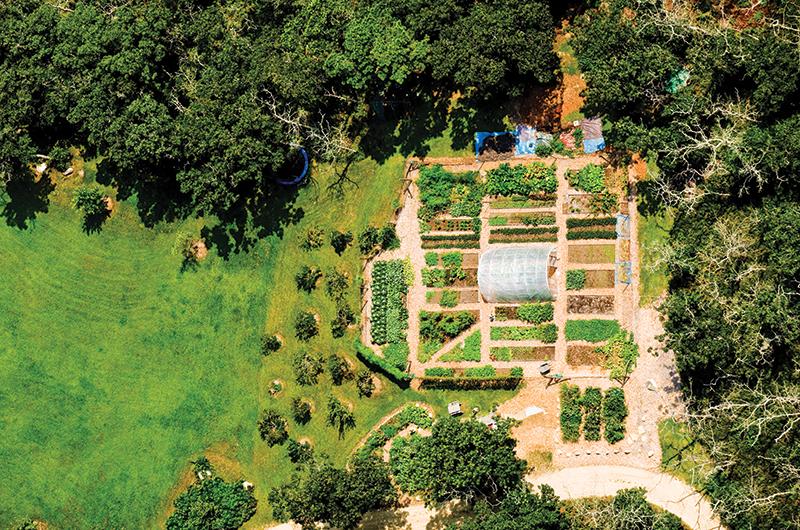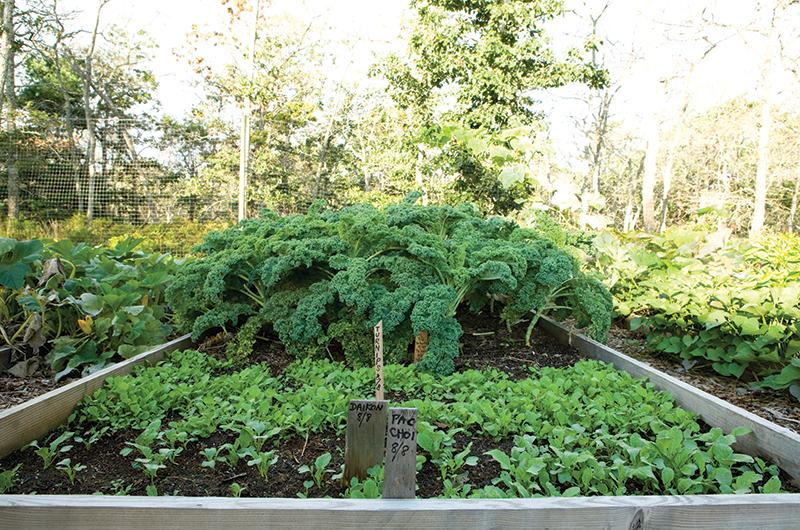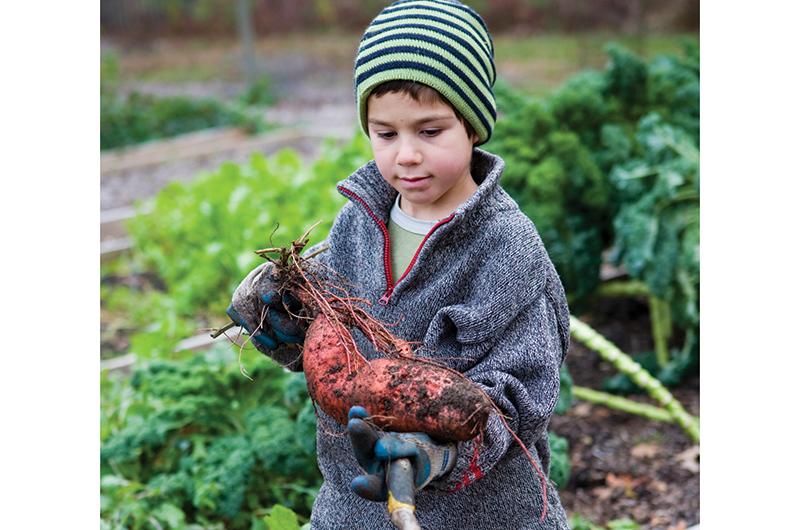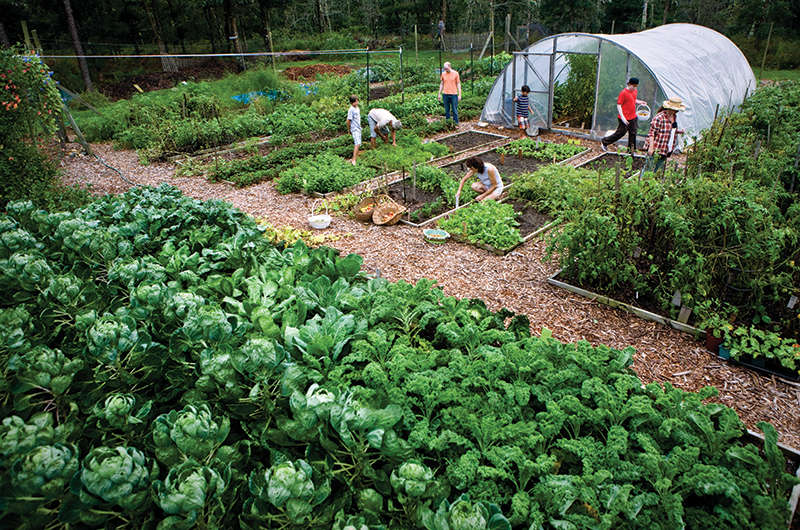Already living a community-oriented lifestyle, the families who inhabit the sixteen homes at Island Cohousing in West Tisbury are further united by the sharing of one large garden – primarily maintained by Cohousers Lynn Weber and Paul Lazes.
Paul had always been one of the main caretakers of the garden, and helped to create it – along with fellow Cohouser and Island photographer Randi Baird – when the first families moved into the complex in the spring of 2000. But when Lynn arrived on the scene in 2006, he says he was happy to hand over the bigger rake.
“I’ve been gardening my whole life, and I’ve known some avid gardeners – Lynn is the best I’ve ever met,” Paul says, adding, “She always gets embarrassed when I say that.”
“I just work hard,” Lynn professes. But it’s more than that, a lot more. It’s a daily, year-round commitment and one that requires an intuitive understanding, as well as basic know-how and creativity. It helps that she enjoys it too.
“I really like all of it. I like being able to keep in shape by doing it. I’ve been committed to the idea of growing my own food forever and ever,” Lynn says. “I’ve been gardening for fifty-five years.” The slim, spry, sixty-nine-year-old has been living on the Vineyard since 1972 and has been a committed gardener here despite all the years of doing the “Island shuffle,” moving between different summer and off-season homes. “I did a lot of gardens and then had to leave them,” she says, living everywhere from Katama to Chilmark to Makonikey, before she and her husband, Tom Andrews, settled into their Cohousing home.
A budding garden
Lynn says before she stepped in, Randi and Paul had done a lot with the garden, which was modeled on the innovative gardening techniques of Eliot Coleman, horticultural teacher and author, who hosted the Learning Channel show Gardening Naturally – a co-project with his wife, Barbara Dam-rosch. They now operate Four Seasons Farm, the gardening website named for their commercial, organic farm in Maine.
Paul, who now splits his time between the Island and New York City, says the large, moveable greenhouse – occupying a prominent spot in the Cohousing garden – is fundamental to its success and is a centerpiece of Coleman’s philosophy. “His thing was using these unheated plastic structures each season, and you move them back and forth.” Coleman traveled the globe along the same latitude as the farm in Maine to prove his theory about growing similar fruits and vegetables. Paul explains, “You’d get the same light level, and if you could just change the heat, then you could grow anything.”
The portable greenhouse (a tube-shaped structure covered in plastic) sits over cold frames, which are south-facing, glass-enclosed structures that further insulate the more delicate crops, seeing them through even the frostiest winter nights. The double-insulation system enables Lynn to grow a variety of vegetables throughout the calendar year: lettuce, tatsoi, arugula, spinach, Swiss chard, daikon, parsley, scallions, cabbage, onions, and Italian dandelion – that is, chicory.

Lynn says the greenhouse serves them well – not just in winter. “We eat out of this all year round,” she says. “It extends the season for tomatoes, eggplants, and peppers.” Around the first week of November, it is moved to protect the winter crops, which will already be planted in beds that are the correct dimensions. “Ten or twelve people have to pick it up, walk it over here, and plop it down.”
The pecking order
Paul and Randi have contributed a lot to the upkeep of the garden, along with a couple of other families, Lynn says, but everyone else participates to some degree. “There are about three or four families who do the major part of the gardening, and then other people from time to time will help out. If we need help with anything, and we ask for it, somebody is always willing.” Lynn says she realizes she has more time, so she’s happy to be out there every day when other members of the Cohousing community can’t be. She admits, however, there are moments when she could use more help, like when it comes to cleaning out the compost bin: “Not a lot of people volunteer for that one! It’s deep. You have to have one person down in there filling up the buckets. One year my grandsons helped. They still remember.”
Also, Lynn says, there are always other projects she’d like to see realized: “I would cover the whole garden with chips, I wish somebody would say, okay, we’ve got ten people and we’re going to spread the chips.” She says she’s not comfortable asking for help. “It’s hard to ask. I don’t want to impose or feel like the garden nag.” But when she does ask, Lynn says, “A big project, like moving the greenhouse or digging the beds outside, people always pitch in.”
And most of the families reap the rewards too, though it’s a little like the old adage that you can’t please all of the people all of the time. “Usually there’s not enough to supply all of the vegetables for all sixteen houses, with between two and four people per house, and kids,” Lynn says. “Some people just pick certain things.The strawberries are always really popular – the lettuce and tomatoes.” Plus she says they will pick surplus vegetables and distribute them among the families, or leave them in the common house.

The families help out in a less obvious way too – by composting food waste, which Lynn uses for fertilizer. She believes that a garden can be a wholly self-contained and self-stimulating universe, using everything from her (and in this case, their) own backyard – including, along with food compost, all yard scraps. “I love that idea that we’re using everything,” she says. “We rake all the leaves – we use them. We save the grass clippings and we use them. All of our food waste? We use it.”
Lynn says recycling also played an important role in the construction of the cold frames and a solar dehydrator, where old glass doors and windows were used for the frame. And for a hinge, to open and close the lid, “I just used an old leather belt,” Lynn says. “A child could do it!”
A fresh approach
When Lynn took over as chief gardener, one of the first things she did was to address poor drainage and weed problems. Because the base of the soil bed is clay, she says, “the water would just sit in the paths, and they had done some drainage, but I built raised beds to raise it up.” To help control the weeds, with the added bonus of also improving drainage, Lynn laid down carpet – yes, pieces of ordinary house carpet that she got from the thrift shop and Karpet Kare, both in Vineyard Haven: “It was just dirt and a lot of weeds. To control that, I put carpeting in between the beds, just tear-outs.Then I put chips over the carpeting, and that way you know where the paths are and you’ve got your weeds under control.” Plus, she adds, “You don’t have to mow in between the beds anymore.”
Lynn also created cutting-flower and herb gardens, mostly transplanting existing plants from the central garden. “These two areas didn’t exist either; this was all just scrub stuff. I wanted a place for flowers and herbs that could take them out of the [vegetable] garden.” She says, “We got a work party and people did some digging. Those beds are deep, and it was like digging in cement.”

Now most of the land designated for the garden has something growing most of the time, with crops rotating seasonally. “As soon as things come out, when any crop is done, I plant it with something else, until the first of September. Keep the land used as much as possible,” Lynn says. Any areas that do not have active crops, especially beds that will be empty for the winter, get a load of seaweed. “My husband and I go to the beach and get a bunch of seaweed,” she says. “It enriches the soil, gives it minerals, it’s a great mulch, and it breaks down over the winter.”
Lynn says she used to plant winter rye, which served the same purpose as seaweed, but the downside of using rye is that it has to be tilled in the spring – twice. “Tilling disturbs the eco-system of the soil,” Lynn says. “We used to till when we were trying to establish better soil – but now that the soil has a huge amount of compost and humus and seaweed – all of the things we put in there – we choose not to till it if we can help it.”
And the beds don’t have to be empty to get a dose of seaweed: “Things that are outside the greenhouse that are still growing – carrots and beets – we mulch with seaweed. And if you put a heavy enough layer of mulch, they won’t deep freeze.”
She says the winter plantings also include a lot of dark, leafy greens. “Starches convert to sugar in the winter and they get sweeter: cabbage, kale, collards – we have a lot of kaleuntil March. And then there are parsnips we won’t even touch until March.”
A healthy harvest
Paul says after Lynn stepped in, his growing duties became “strictly salad,” with most of his energy going to lettuce and tomato crops. He says there’s a big advantage to growing lettuce. “Most of your crops, they have to mature, they happen, and then they’re over. Lettuce you can keep going literally all twelve months. You’re constantly growing and constantly eating.” Paul didn’t mind when Lynn took over and he says he has learned from her. “She’s better than me and she’s more industrious, so I just got out of the way,” he says. “I’m a big believer in if somebody else will do it, let ’em.
“She doesn’t miss a trick. She’s thorough.” In fact, Paul says, “I’m not anti–commercial fertilizer – I think most people who are just don’t understand the science, and it has problems – but I’ve always thought that no matter how much you do with organic, if you throw some of that [commercial fertilizer] in the mix, you’ll get a better product.” After working with Lynn, he says, “I’m convinced now that you can grow organically as potently. The product is as robust and perfect looking as you could get.”
Lynn also emphasizes the economical benefits of growing your own food, and after tracking it for a year, estimates that she and her husband spend on average only $20 per week at the grocery store. “And that’s including cat food,” she adds.
And, though Lynn says it’s not exactly the driving force, she doesn’t deny the artistic aspect of her approach to gardening. “I look at this as my palette, if I were an artist. I think about the textures of the plants, what’s going to look good.” But, she says, “It’s very hit or miss.I don’t really think in terms of what’s going to look good, but when it happens, I appreciate it. It’s mostly practicality that drives everything. The aesthetics are accidental.”
Recipes from Island Cohousing
Sund Dried Tomato and Pesto Pizza
The Solar Dehydrator
In one corner of the Island Cohousing garden is what appears to be a smaller, glass-walled greenhouse that is actually a drying facility. “We have the solar dehydrator that I built,” Lynn Weber says, “that holds twelve cookie sheets full of whatever you want to dry.” She says she simply cuts the fruit or vegetables and lays them out on the trays – skin side down – to dry, which takes about three days.
“I dry strawberries, tomatoes,” Lynn says, “cherry tomatoes, all different varieties‘San Marzano’, long cylindrical, not so juicy that they don’t dry. ‘Principe Borghese’ is good too.That’s like a smaller ‘Roma’.”
The dehydrator is a way to deal with some of the surplus fruit from the summer and share it with the community year-round. “I don’t let them get totally crispy dry, and then I put them in baggies,” she says, some for the common house freezer and some for her own.







